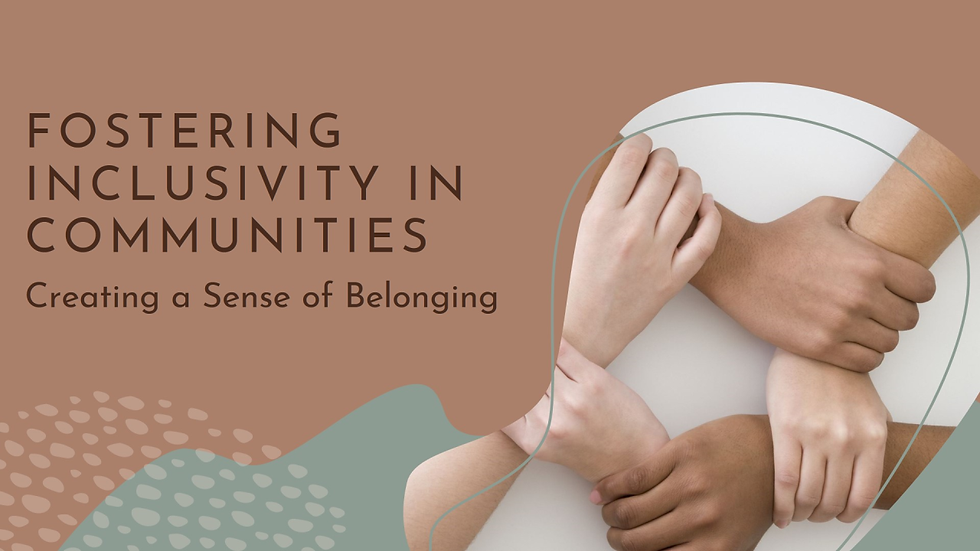How to Create a Sense of Belonging: Fostering Inclusivity in Communities
- Chaitali Gaikwad
- May 13, 2024
- 3 min read

A sense of belonging is fundamental to human well-being, providing individuals with a sense of connection, acceptance, and identity within their communities. In an increasingly diverse and interconnected world, fostering inclusivity is essential for creating environments where everyone feels valued, respected, and empowered. In this blog, we'll explore practical strategies for creating a sense of belonging and fostering inclusivity in communities of all kinds.
Understanding the Importance of Belonging:
Belonging is a fundamental human need that influences our physical, emotional, and psychological well-being. Research has shown that individuals who feel a sense of belonging report higher levels of happiness, satisfaction, and resilience. In contrast, feelings of exclusion or marginalization can lead to negative outcomes such as loneliness, isolation, and poor mental health.
Creating a Sense of Belonging:
Promote Diversity and Inclusion: Embrace diversity and create inclusive spaces where individuals from all backgrounds feel welcome and respected. Celebrate cultural heritage, recognize diverse perspectives, and challenge stereotypes and biases.
Build Community Connections: Foster connections and relationships within the community by organizing social events, networking opportunities, and community-building activities. Encourage collaboration, cooperation, and mutual support among community members.
Provide Opportunities for Participation: Offer opportunities for community members to contribute their skills, talents, and ideas. Create volunteer opportunities, leadership roles, and committees where individuals can actively participate and make meaningful contributions.
Facilitate Open Communication: Create channels for open and transparent communication where community members feel comfortable expressing their thoughts, concerns, and feedback. Encourage active listening, empathy, and constructive dialogue.
Create Safe and Inclusive Spaces: Ensure that community spaces are safe, welcoming, and accessible to all individuals. Address physical and environmental barriers that may hinder participation and create a culture of respect, acceptance, and support.
Acknowledge and Validate Experiences: Validate the experiences and perspectives of community members, particularly those from marginalized or underrepresented groups. Acknowledge the impact of systemic barriers and discrimination and work to address inequities within the community.
Provide Support and Resources: Offer support services, resources, and referrals to community members in need. This may include mental health resources, social services, educational opportunities, and employment assistance.
Empower Community Leadership: Empower individuals from within the community to take on leadership roles and advocate for positive change. Provide training, mentorship, and support to emerging leaders and amplify their voices and initiatives.
Celebrate Achievements and Milestones: Recognize and celebrate the achievements, contributions, and milestones of community members. Highlight success stories, showcase talents, and foster a culture of appreciation and gratitude.
Promote Collective Well-Being: Foster a sense of collective well-being and social responsibility within the community. Encourage acts of kindness, compassion, and altruism that benefit the broader community and promote the common good.
Challenges and Considerations:
Creating a sense of belonging and fostering inclusivity in communities is not without challenges. Common challenges include resistance to change, cultural differences, language barriers, and power imbalances. Additionally, addressing systemic issues such as discrimination, inequality, and social injustice requires ongoing commitment, collaboration, and advocacy.
Conclusion:
Creating a sense of belonging and fostering inclusivity in communities is essential for promoting individual well-being, social cohesion, and collective prosperity. By embracing diversity, building connections, and providing opportunities for participation and engagement, communities can create environments where everyone feels valued, respected, and empowered. Through collective effort, compassion, and empathy, we can build stronger, more inclusive communities where all individuals can thrive and contribute their unique talents and perspectives.




Comments